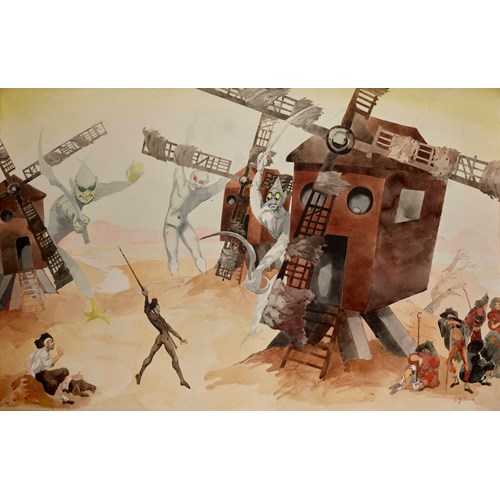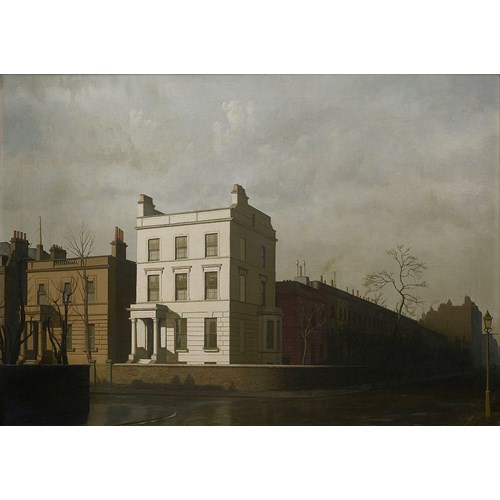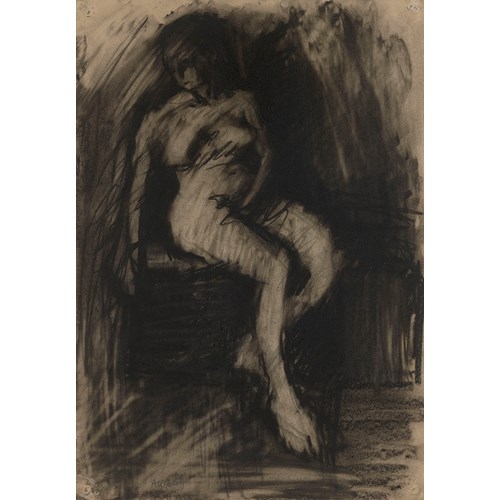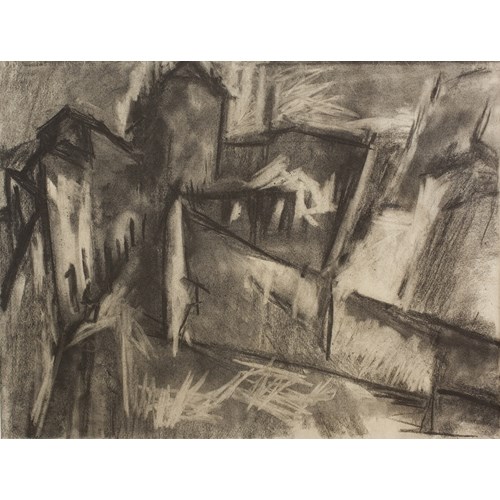Johan Tobias SERGEL
River God
Date c.1770
Medium Terracotta
Dimension 42.5 x 40 x 32.5 cm (16³/₄ x 15³/₄ x 12³/₄ inches)
The greatest examples of Sergel’s sculptural oeuvre can be found in the Nationalmuseum in Stockholm, which acquired all his wax, plaster and terracotta models shortly after his death. As a result, his work remained unknown to subsequent generations of European sculptors, and it is only in recent times that he has begun to achieve the place in art history that is warranted by his great gifts and his pioneering contribution to the Neoclassical movement.
This newly discovered sculpture, depicting a River God, is likely the same one that was recorded in the estate register of Sergel’s home, Sponga, on 12th May 1814 and which has since been missing for over two centuries. From the list it appears that in the vestibule at Sponga manor was Sergel's masterpiece Otryades, modelled in terracotta in 1779, a Faun, also executed in terracotta in 1770, as well as a River God in the same material. Other terracotta sculptures were found in the "Large Atelier" and "Smaller Atelier". Thanks to a far-sighted intervention by the civil servant Fredrik Samuel Silverstolpe, who after a career as a diplomat became head of the Office of the Inspector-General in 1813-1836 and head of the Royal Museum, a number of key works from Sergel's workshop were acquired. The collections in the Royal Museum would later form the basis of the Nationalmuseum in Stockholm.
The professor Ragnar Josephson writes in his monograph, of 'Sergel's fantasy': "Sergel's plastic sketches are largely preserved. The credit goes to Fredrik Samuel Silverstoples who, after Sergel's death, proposed on June 27, 1815, that the state must purchase all of the sculptor's models in fired clay or wax. There were thirty-one such pieces.
A comparison with the National Museum's existing works from the state purchase in 1815 and the estate register shows that all the terracotta sculptures were acquired except for the River God, whose further fate was subsequently raised in obscurity and eluded art historians. Ragnar Josephson writes: "Finally, in his sketchbook there is a drawing in the Puget style. Since we know that he modelled a river god, which was after his death in his Stockholm home, but is now lost, it can be suspected that it was added in Paris. "In the valuation of the property, it appears that Otryades and Faunen were valued at 15 riksdaler, while the River God received a more cautious valuation of 4 riksdaler, however, it can be put in relation to the terracotta relief of the Farnese Hercules which was also valued at 4 riksdaler.
The source of inspiration for the River God is the Flemish-Italian sculptor Giambologna's river god Euphrates, executed in terracotta around 1575, as a model for the monumental Sea Fountain in the Boboli Gardens, Florence. Giambologna sculpted the final version of the marble fountain where the river gods Euphrates, Ganges and Nile sit below Neptune, commissioned by Grand Duke Cosimo I de' Medici, whose son Ferdinando I de' Medici founded the Villa Medici in Rome. The art historian Oscar Antonsson states in his book Sergel's youth and Roman times that Sergel was strongly influenced by Giambologna's mannerist sculptures, in the same way that the ancient world of form opened up through spectacular collections of Roman sculpture and not least the archaeological breakthroughs made through excavations during the 18th century in Italy.
Sergel had received a state scholarship on October 14, 1766, to travel to Italy and immerse himself in the country's rich architecture, sculpture and painting. Between the years 1767–1778 he stayed in Italy, after which he returned home via Paris and London, before he was back on Swedish soil in the summer of 1779. During the period 1768-1774, all of Sergel's Roman sculptures were conceived in a sequence, where the terracotta occupies a special position under his years in Italy. Ragnar Josephson writes: "There was no kiln for firing at the Art Academy then, just as there is none to this day. In Rome, Sergel learned the Italian method of firing the Italian clay suited to it; the terracotta was the original work, and preserved all the nuances of the modelling hand, which plaster casts did not. "
One of Sergel's earliest surviving works from Italy is the terracotta sculpture Milon, which has points of contact with French sculptor Edme Dumont's reception piece, Milon de Crotone, executed in marble in 1768 (Louvre inventory number MR 1839). Sergel's Milon was part of the collections at Huseby bruk and had reportedly been acquired by Professor George Stephens in the 1840s from the artist Egron Lundgren. The sculpture was sold in 1997 via Nordén's auctions in Stockholm. Unlike the River God, Milon is more sketch-like but still connects with the same powerful expression in the elaborate male body and its muscular strength. The River God glorifies the human body, a key interest of humanism, balancing on one foot the figure creates an impression of exaggerated physical strength. Among Sergel's legacy was also the high relief from around 1770, Farnese Hercules which, as mentioned, was valued at the same amount as the River God. In the three-dimensionally modelled terracotta relief, the mythical Hercules appears with all his raw strength conveyed through Sergel's sense of form and anatomical knowledge. What Milon, Hercules and the River Godhave in common is that they were all executed during the time when Sergel created large, free sculpture, where all of them were preceded by copying antique sculpture.
Not only did Giambologna inspire Sergel in the 18th century, the French sculptor Jean-Jacques Caffieri also showed a plaster model entitled Un Fleuve at the Paris Salon of 1757 (No. 133), which was also executed in marble as his reception piece to the Academy on 28 April 1759 and was shown in the Salon the same year (no. 148). Caffieri, who in the years 1749-1753 was a scholar at the Villa Medici, had evidently seen Giambologna's River God and made his own variation which can be found in the collections at the Louvre. Caffieri’s sculpture has an obvious kinship to the present terracotta of the River God and Giambologna's. On his return from Italy, Sergel spent a few months in Paris in 1778, where he met the director of the academy, Jean Baptiste Marie Pierre, who complimented Sergel on his Faun and asked him to make a reception piece for the French Academy of Arts. The subject chosen by Sergel was the Otryades, which was shown to the board of the academy in a plaster cast after the modelled terracotta. Among the members were several of the most famous contemporary artists and the sculptor Caffieri, who accepted Sergel at the French Academy.
A common feature of many of Sergel's terracotta sculptures are firing defects as a result of the difficult-to-control firing kilns in which the clay was fired. Sergel himself writes in correspondence that he always worked with fine-grained Roman clay, which he got used to during his scholarship period in Italy. Furthermore, the sculptures were reinforced with forged iron tines to give stability to the massive clay, which is evident from damage to the present River God and Milon but also from x-rays of the sculpture Germanicus in the National Museum, Stockholm. Some of the preserved terracottas at the National Museum are signed by Sergel in clay. Georg Göthe writes about the signing of Sergel's portrait: "His most common signatures were 'Sergel' with or without a subsequent 'f' (ecit) and the year. But other signatures also occur, especially in the older period: 'S', 'I S ', 'I S' in monogram, 'S-l', 'J. Sergel'.
The present work personifies the Euphrates, god of the Assyrian and eastern Anatolian river, much in the same way Giambologna’s model did some two hundred years earlier. Sergel’s fascination with the athletic human body, however, is a striking feature and embellishes his model with great verisimilitude. The rendering of almost superhuman musculature and the delicately modelled skin creates an elegant play of light and shadow with more nuanced transitions. The figure leans forward to pour the water from his great amphora, emphasising the muscular tension in his right arm and leg. His back is powerfully arched, and the abdominal muscles further rendered to support his great torso. The (now missing) left arm clutches the bedrock behind him, whilst his left leg guides the amphora with his foot protruding outwards. The present work is an essay in muscular tension and power. It is entirely possible Sergel was influenced by the impressive frescoes executed by Annibale Caracci in the Palazzo Farnese in Rome, dating to c.1600. The exaggerated athleticism of the figures bear much similarity, in particular, Hercules & Lole and Europa & the Bull.
Date: c.1770
Medium: Terracotta
Signature: Signed in pencil 'S' to the base
Dimension: 42.5 x 40 x 32.5 cm (16³/₄ x 15³/₄ x 12³/₄ inches)
Provenance: From the estate of the sculptor Johan Tobias Sergel, in his register of succession of May 12th, 1814. Registered as "1 Figur, FlodGud, af bränd lera" in the vestibule of Sponga Manor, parish of Ärila, Södermanland.
Acquired by the previous owner as part of an anonymous sale of property at
auction in Sweden in 2023, to 2024
Acquired from the above.
Literature: Georg Göthe: Johan Tobias Sergel's sculpture works, Stockholm 1921, page 39,
section on Sergel's signatures; plate 12, comparing Jupiter and Juno in terracotta;
plate 67, compare The Farnesian Hercules, signed I.SERGELL
Oscar Antonsson: Sergel's Youth and Time in Rome, Stockholm 1942, page 154, compares Milon executed in terracotta by Sergel; page 207, regarding Giambologna's influence; plate 12, compares the modelling of the tree trunk in Mercury and Psyche; plates 14 & 15, compares the treatment of musculature in Tobias with the fish; plate 20, compares detail of the painting in Sergel's own signature on Faunen.
Ragnar Josephson: Sergel's fantasy, previous part, Stockholm 1956, page 152ff, image 156f, compares Milon executed in terracotta, page 271, text and image 380, section on the river god.
Nordén Auktioner, Art and antiques, autumn auction 1997, no. 276, Milon breaks the oak, terracotta, by Johan Tobias Sergel.
Magnus Olausson & Eva-Lena Karlsson ed.: Sergel and his Roman circle - European terracottas 1760-1814, Stockholm 2004, page 46ff, article on Sergel and the terracotta; page 108, compares drying and burning cracks on the sculpture ‘Achilles and the centaur Chiron’; page 188 & 196, compares picture and text about the Farnese Hercules.
More artworks from the Gallery


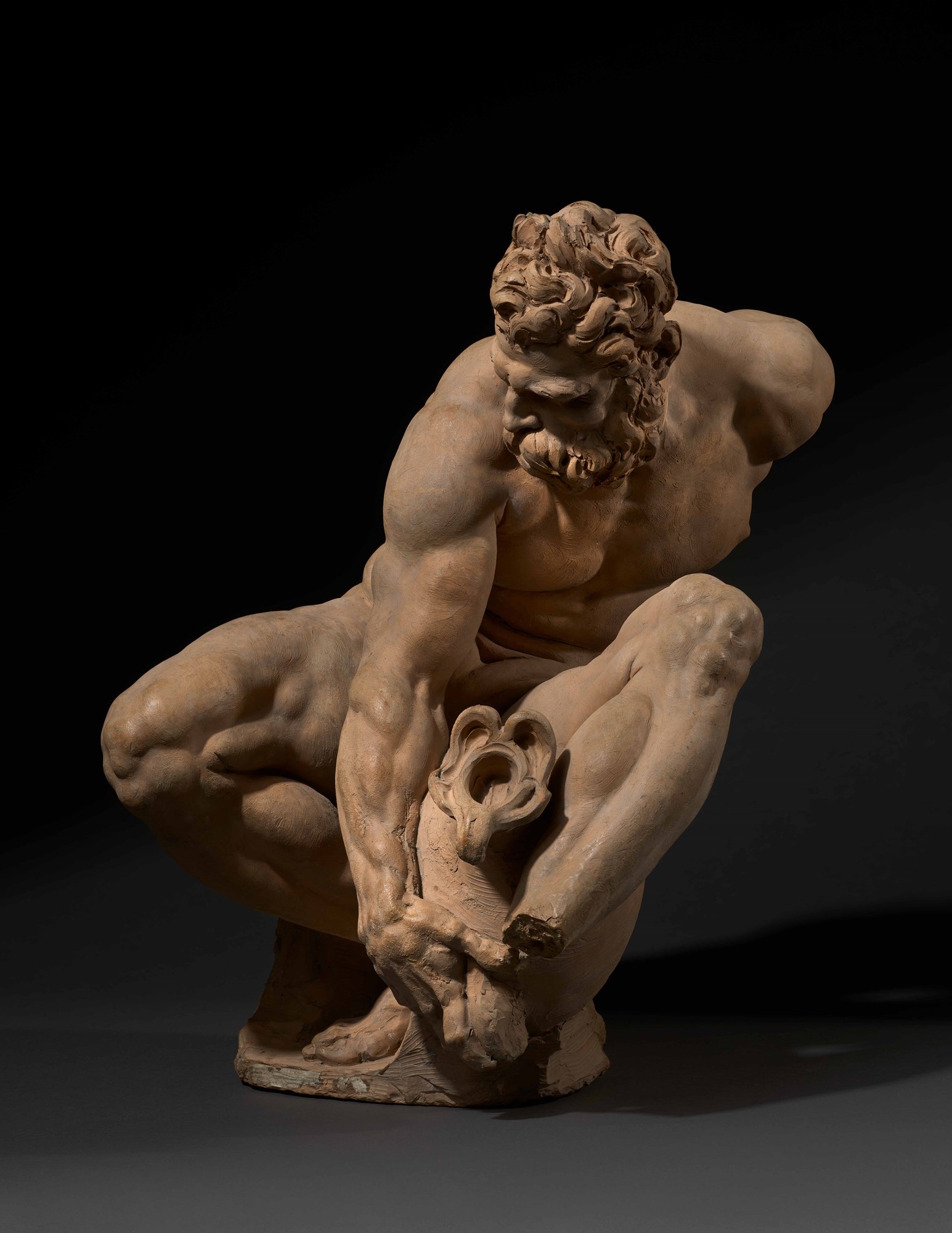

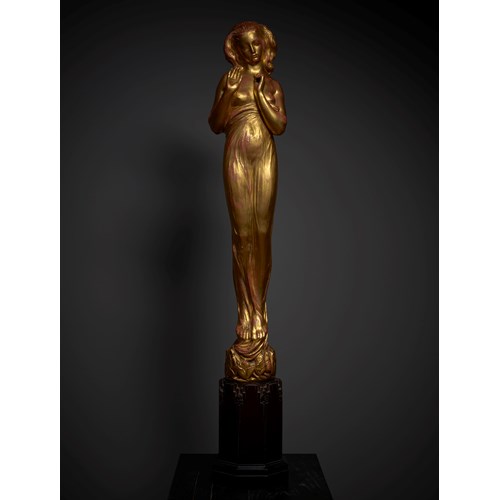
_T638676151429242934.jpg?width=500&height=500&mode=pad&scale=both&qlt=90&format=jpg)
